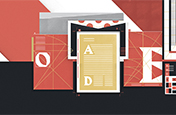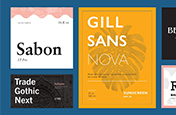How to become a graphic designer
Graphic design skills are all around us - from designer shoes and trainers to luxury food packaging. But how do you go about becoming one of the professionals creating this work?
Our handy guide sets out how to become a graphic designer. From education and training to career paths, here, we’ll explore the fundamentals of launching a career in graphic design.

What is a graphic designer?
Graphic designers are, essentially, visual storytellers. They create concepts and artwork - sometimes manually and, at other times, using sophisticated software alongside well-honed graphic design skills.
Their illustrations help to convey a message to target audiences and communicate vital information at a glance. Often, the design elements come together with text to create a compelling narrative.
From advertising and publishing to manufacturing and marketing, many industries employ their talents. So, there are various career paths to follow to become a graphic designer.
What does a graphic designer do?
Graphic designers are responsible for creating engaging visual concepts. Organisations use these within their marketing resources and campaigns, in conjunction with website design, social media pages, banners and PPC ads.
They also create visuals for materials such as:
- Logos
- Email campaigns
- Brand packaging/product design
- Presentation decks
- Business cards
…and much more. When it comes down to it, graphic designers are usually responsible for all the commercial things that require visual storytelling.
Key responsibilities of a graphic designer

The job of a graphic designer can be diverse. From initial concept creation to producing final signed-off designs, there’s a lot involved in an average day.
If you’re contemplating training to become a graphic designer, you’ll likely be responsible for many things, ranging from elements of UX (user experience) to product work and digital infographics.
Every employer will have unique requirements, but there are some common responsibilities and expectations for what a graphic designer has to do. These will typically include:
- Communicating with clients. You’ll need to understand their requirements, budget and timeline, as well as work with their ideas and guidelines to reach a common goal. Updating clients on your progress and actioning their feedback is also key.
- Working with internal teams. A key role of most designers is to work closely with colleagues, such as copywriters and art directors, to achieve uniformity in storytelling and messaging. Attending meetings and workshops can help you to understand company and campaign goals.
- Being creative. Of course, you’ll naturally be using your creativity every day. Whether that’s to create concepts, layouts and mock-ups or photo editing and reviewing final design layouts, there’s plenty of room for artistic inspiration.
- Keeping on top of things. Being a designer can be a high-pressure job. You’ll be expected to ensure all deadlines are met and keep up to date with the latest design trends software changes.
These are just some of the key responsibilities of a graphic designer, as they will vary depending on the agency or brand. For example, freelance graphic designers usually have different responsibilities from in-house designers.
Working hours

Most people are expected to work Monday to Friday office hours once they become an in-house graphic designer. Unless you’re logging in remotely from a different location (or working part-time), this would typically mean the standard 9-5.
However, freelancers will often work to a different schedule, depending on client requirements. A freelance graphic designer working for a client based abroad may have to be available during the client’s business hours to attend meetings and accommodate feedback.
Graphic designer salary and earnings
How much you earn as a graphic designer will depend on various factors, including your skill set, experience, the graphic design job market and the company you work for.
As a rough guide to a graphic designer’s salary in the UK, according to Glassdoor’s salary ranges tool(1):
- Junior Graphic Designer salary can be £20,000 to £25,000(2)
- Middleweight Graphic Designer salary can be £26,000 to £39,000(3)
- Senior Graphic Designer salary can be £35,000 to £49,000(4)
Graphic designer salaries in London are generally higher than in the rest of the country.
How much do graphic designers make as freelancers?
The pay for freelance graphic designers depends on several factors, such as location, experience and what the client is prepared to offer. Junior designers in the UK generally charge from around £25 an hour . You can also charge people a fixed amount per job or by milestone.
It’s a good idea to start by offering a competitive rate that will tempt prospective clients. You can always charge less to begin with, build a good portfolio and grow your reputation, allowing you to subsequently raise your rates. Freelance graphic designers can make from £250 a day (or even more).
There are numerous freelancing platforms where you can sign up for free and start working. Some of the most popular include:
- Upwork
- Freelancer
- Fiverr.
(1) - Glassdoor.com/blog/glassdoor-salary-ranges/
(2) - Salary: Junior Graphic Designer in United Kingdom 2024 | Glassdoor
(3) - Salary: Graphic Designer in London, UK 2024 | Glassdoor
(4) - Salary: Senior Graphic Designer in London, UK 2024 | Glassdoor
Guidance on how to become a graphic designer
To become a graphic designer, you’ll either follow an academic or vocational route. In recent decades, it has become more common for aspiring designers to attend university, but vocational apprenticeships are making a comeback.
In terms of suitability, anyone with a passion for creativity and a vivid eye for detail has the potential to embark upon this career. But you’ll need to gain relevant qualifications, as well as developing graphic design skills and experience.
With training and education for graphic design, you’ll generally study at college or university before getting your first job. As well as education, you may want to consider other forms of training, such as work experience and graphic design workshops.
You can become a graphic designer without a degree. The main non-degree route is via a specialist creative and design apprenticeship which we’ll talk about in detail later.
Become familiar with basic principles and tools.
Understanding core principles of design will help to provide a solid foundation for starting on a graphic design career path. To help you to get started, you can read up on:
- Logo ideas
- Pixel art
- Typesetting
- Colour meaning
- Design thinking
- The Golden Ratio.

Get a feel for the digital tools you’ll use to create conceptual artwork. Graphic designers at all levels use Adobe Creative Cloud, which is the industry standard toolset. Sign up for a free trial of Photoshop or Illustrator to build your graphic design skills.
What qualifications do you need to be a graphic designer?
If you’re serious about becoming a graphic designer, you may want to consider the education and training you’ll likely need. For example, this may include graphic design certifications, like a degree.
Graphic design education at school and college
If you’re still at school, you may opt for NCFE Level 1/2 Technical Award in Graphic Design or a GCSE in Graphic Design and Technology. These courses are aimed at people aged 14-16 but can also be studied at an older age(5).
After your GCSEs, if you’re planning to study graphic design at university, you’ll need to gain the required UCAS points. You have two options:
- A-levels, i.e. in Graphic Design or related subjects like Fine Art or Design Technology. Entry requirements: at least five GCSEs at grades 9 to 4/A* to C/ at least grade 6 in the specific subject(s) you want to study(6).
- BTEC Level 3 Diploma in Art and Design or other related subjects such as Creative Practices(7). Entry requirements: Any grade 4 GCSE Art and Design or grade 4 GCSE Technology(8).
Graphic design education at university
Most people who become a graphic designer do so via university. So, after school and college, this is likely the next stage of your graphic design training.
Most universities across the country offer BA graphic design courses. On these, you’ll learn skills for Adobe Photoshop, InDesign and Illustrator, along with colour theory and the principles of print media and digital design. Entry requirements are generally 3 Bs at A-level or a BTEC Level 3 Diploma(9).
From there, you may also choose to study for a postgraduate degree, for example, an MA in Graphic Design. To do this, you’ll generally need to have gained your undergraduate degree.
(5) - https://www.ncfe.org.uk/qualification-search/qualification-detail/ncfe-level-12-technical-award-in-graphic-design-1723
(6) - https://www.ucas.com/post-16-qualifications/qualifications-you-can-take/levels
(7) - https://www.arts.ac.uk/partnerships/ual-awarding-body/qualifications/art-and-design/ual-level-3-diploma-and-extended-diploma-in-creative-practice-art-design-and-communication
(8) - https://nationalcareers.service.gov.uk/find-a-course/details?courseId=be387f93-b6de-454c-b779-5d23c63245ee&runId=72d10cf9-0cff-4d89-880b-3d1136e18021&searchTerm=itq%20level%203&town=&courseType=[%22%22]&courseHours=[%22%22]&courseStudyTime=[%22%22]&startDate=&distance=&filtera=False&page=653&orderByValue=Relevance&co-ordinates=&campaignCode=&qualificationLevels=
(9) - https://www.ucas.com/explore/subjects/graphic-design#subjects-its-useful-to-have-studied-firstd
Graphic design skills
Whereas an artist uses artistic mediums to express an idea, a graphic designer uses creative competencies and skill to communicate a brand identity and/or philosophy.
Let’s look at the skills and abilities you may need:

Knowledge of marketing
If your visual art is going to help businesses convey their brand vision - and be the frame on which marketers and writers build the body of their campaign - it’s essential to have a solid understanding of marketing.
Enrolling on a course, spending some time working in an agency or reading up on core principles will all go a long way.
Desirable soft skills
To be successful, you’ll need more than creative and technical graphic design skills. Soft skills are important too. In fact, according to LinkedIn’s Global Talent Trends(10), 92% of talent professionals reported that soft skills are as important as technical skills or hard skills.
To become a graphic designer, you’ll need to be comfortable developing ideas and brainstorming with colleagues, so the ability to collaborate and communicate is key.
Some examples of relevant soft skills for graphic design include:
- Excellent communication
- Empathy and understanding
- Being organised
- Problem-solving skills
- Collaboration and motivation
- The ability to stay calm under pressure
Working knowledge of design software
To become a successful designer, a touch of artistic flair will obviously help - but you’ll still need solid graphic design skills. Strong knowledge and a firm grasp of the most popular graphic design software will be required, including:
How to become a graphic designer without a degree
University is typically the route taken by most people wanting to become a graphic designer. But you can also do it without a related graphic design degree by getting a creative and design apprenticeship(11).
These apprenticeships are designed for young people who want to become graphic designers, fashion designers, writers, journalists or photographers. With these, you will work and study at the same time. Mostly, you’ll be learning the practical skills on the job, but this will be supplemented with studying at college.
There are two levels of creative and design apprenticeships: advanced and degree. The advanced one requires no formal qualifications and can be completed in two years, whereas the degree level one requires GCSEs and A-levels and runs for between three and six years.
(10) - business.linkedin.com/content/dam/me/business/en-us/talent-solutions/resources/pdfs/global_talent_trends_2019_emea.pdf
(11) - www.ucas.com/explore/industry-guides/creative-and-design
Top tips for aspiring graphic designers
- Keep it simple. This is perhaps the most important thing to remember. Overwhelming designs can and do fail to convey their intended message.
- Learn the basics. Understand the fundamental principles of graphic design and learn Photoshop, making use of Adobe’s free Photoshop tutorials.
- Keep your colour palettes consistent. Choose and create your colour palette in accordance with the brand guidelines and stick to them.
- Don’t go overboard with typography. Many designers are guilty of this. Pair your fonts and keep them clean and cohesive.
- Get a grip on visual hierarchy. Know what elements need to ‘shine’ more than others.
- Use the best design templates when possible. Use resources such as free Adobe Express templates to make things easier.
Graphic designer career prospects and other information

How in demand are graphic designers?
Every business and organisation needs visual content - whether that’s for websites, blog banners, email templates or paid campaigns. Talented graphic designers are therefore highly sought-after assets for many companies.
What's the best place to work as a graphic designer?
The dream job for every individual is different. While some people may be happy to work in-house for a certain company, others prefer to work for marketing or advertising agencies and expand their portfolio across several brands - or maybe even freelance.
If you’re intending to go in-house, it’s often best to work for a company that offers support and room for growth.
What are the pros and cons of becoming a graphic designer?
As with all careers, there are benefits and challenges when it comes to working as a graphic designer:
Benefits:
- There are job opportunities in all sectors, which offers room for growth.
- You get to work with other creative people and learn from them.
- You can learn other aspects of marketing and expand your horizons.
- When working for a reputable marketing agency, you’ll have the chance to partner with multiple brands.
- There can be a great work-life balance. Some places may offer you a remote or hybrid position, so you can work from wherever suits you best.
Benefits:
- Work can be demanding at times, especially during peak periods - which could lead to long working hours.
- The job is mainly desk-based, so will involve long hours sitting at your computer.
- If you work as a freelancer, it can take time and a lot of effort, to build your portfolio and earn higher rates.
- The job itself is a very competitive field, so it can take patience and persistence to get your foot in the door.
Start building your portfolio with Photoshop
Get creative and build out your portfolio with eye-catching designs, thanks to the intuitive tools and features of Adobe Photoshop.
Graphic designer: FAQs
How much does a graphic designer earn?
Graphic design pay usually depends on skills, experience and position. However, the average salary for a graphic designer in the UK is around £39,000, with senior graphic designers often making more than £49,000.
What is the lowest salary for a graphic designer?
The lowest wage typically sits at around £20,000. However, this is usually a ‘starting’ or graduate wage. As they progress, most graphic designers in the UK will take home substantially more than the minimum salary.
What subjects are needed to be a graphic designer?
Depending on your college or university, your course will usually focus on:
- Photography
- Drawing
- Illustration
- Digital design
- Design technique
- Visual communication theory
- Art theory
You might also be interested in…
Explore inspiration to help fuel your logo ideas.
Dive into the technical and aesthetic concerns of distilling a brand into a symbol.
Deciphering the art of ambigrams.
Explore ambigrams, a word or design that retains meaning when viewed from another direction.
Picking the right font: Serif vs. sans serif.
Choosing between serif or sans serif fonts means considering user experience, attitude and history.
Learn about kerning and how to use it to improve your typography.



